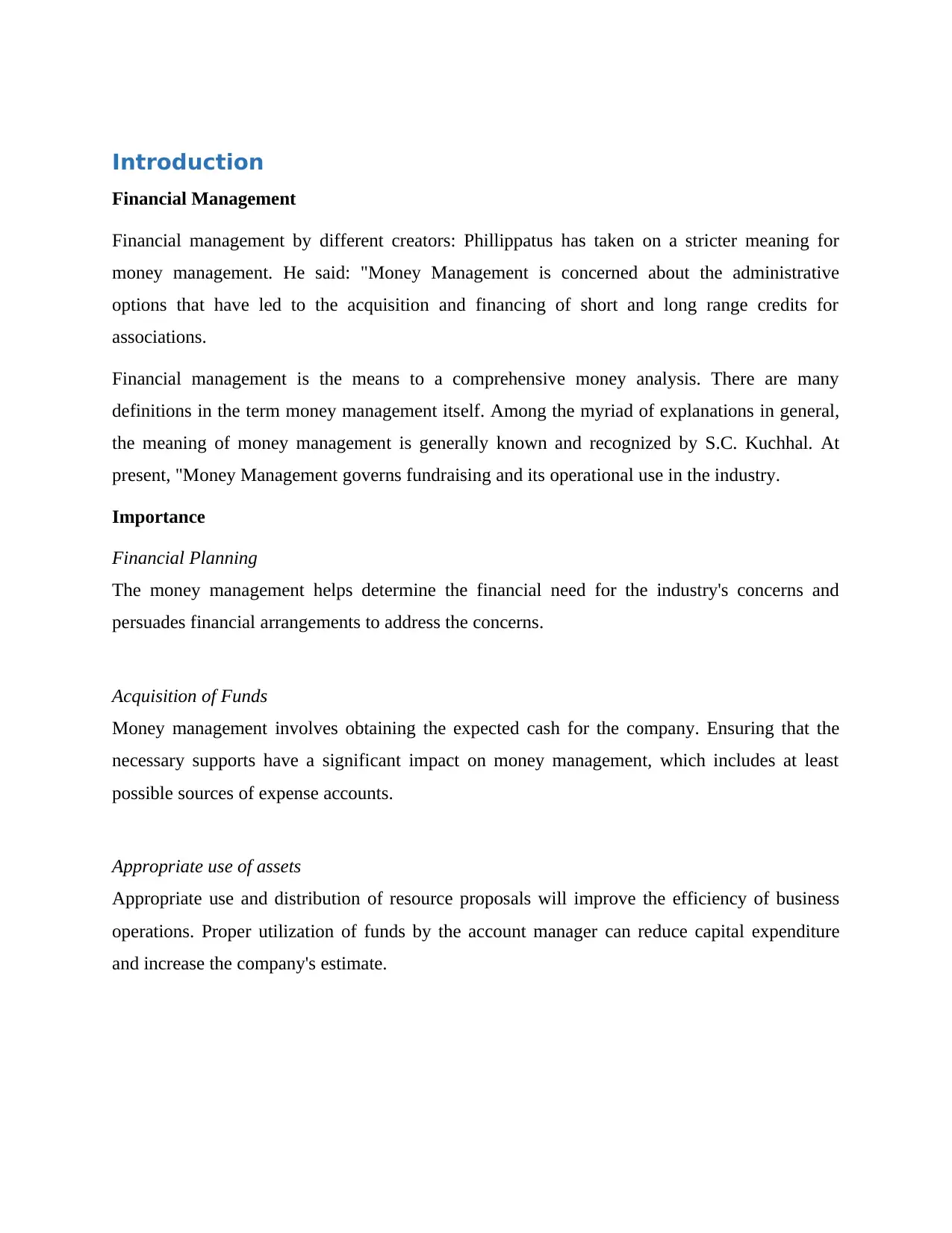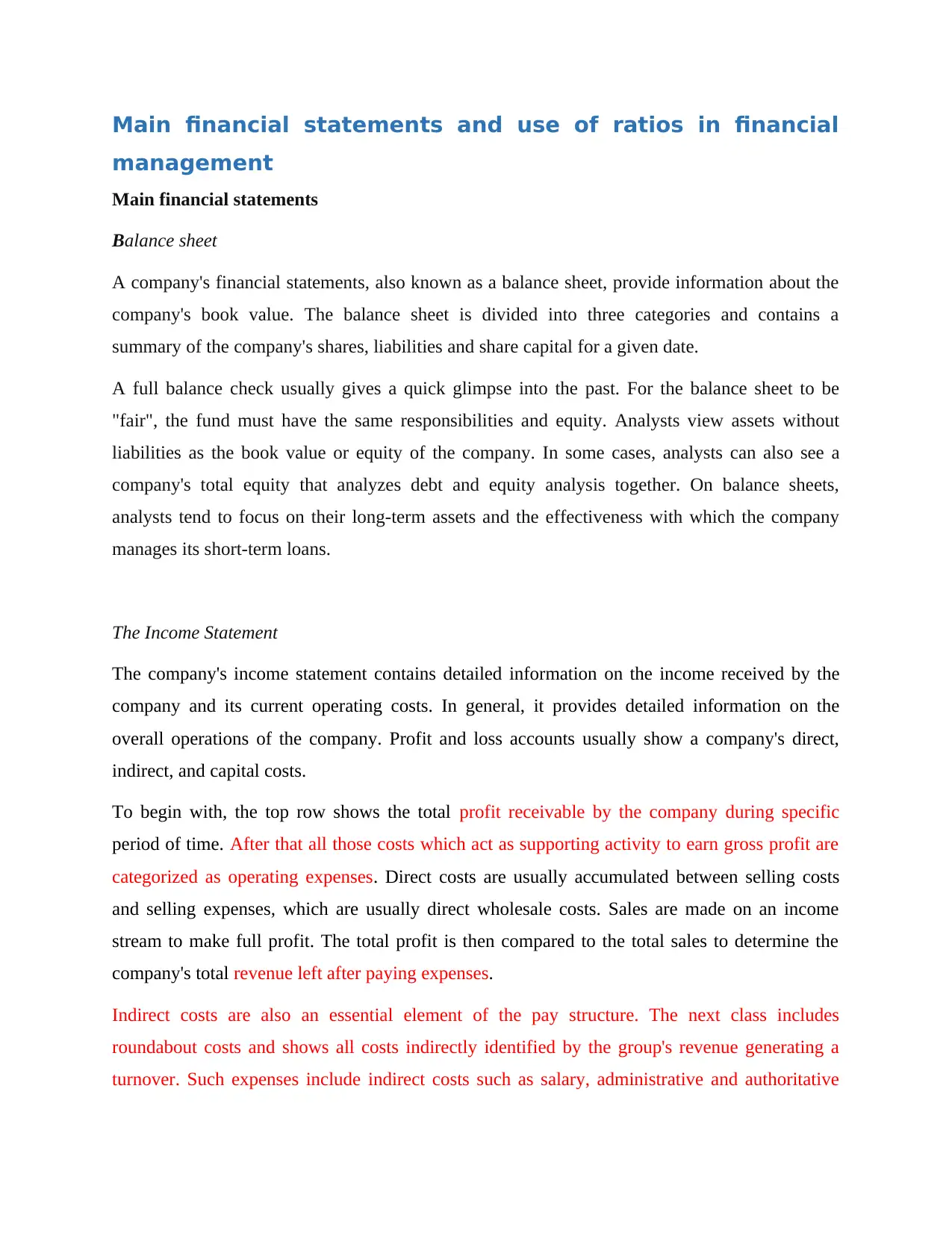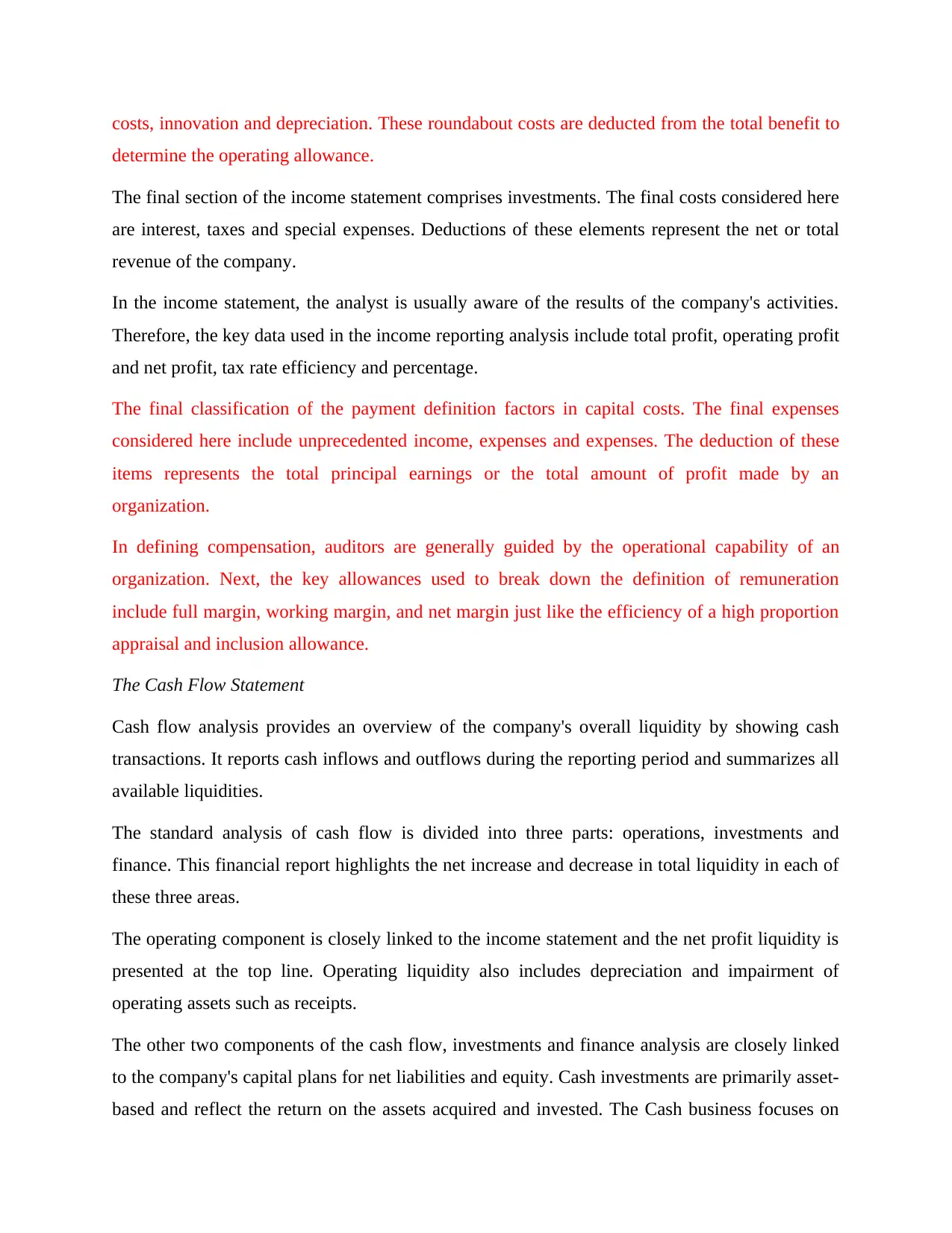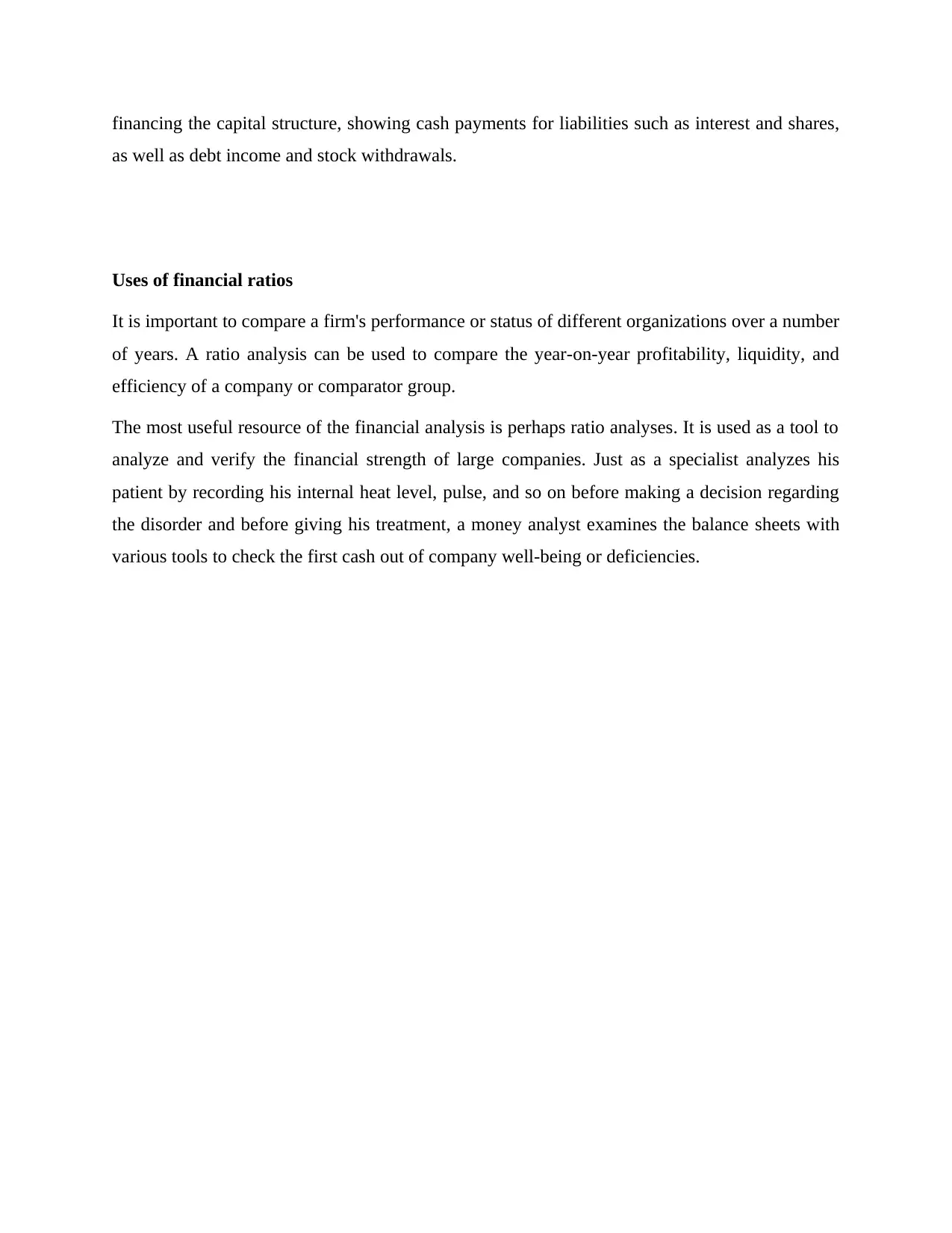Financial Analysis: Main Statements and Ratio Application
VerifiedAdded on 2022/12/26
|6
|1099
|95
Report
AI Summary
This report examines the core concepts of applied business finance, focusing on the main financial statements and the application of financial ratios. It begins by defining financial management and its importance, referencing key figures in the field. The report then delves into the three primary financial statements: the balance sheet, income statement, and cash flow statement, explaining their structure, components, and the information they provide about a company's financial position, performance, and cash flow activities. Furthermore, it explores the use of financial ratios as tools for analyzing a company's performance, liquidity, and efficiency, highlighting their importance in comparing a firm's status over time and against competitors. The report emphasizes how ratio analysis enables a detailed assessment of a company's financial health, mirroring the diagnostic approach used by medical professionals.

Applied Business
Finance
Finance
Paraphrase This Document
Need a fresh take? Get an instant paraphrase of this document with our AI Paraphraser

Table of Contents
Introduction......................................................................................................................................3
Main financial statements and use of ratios in financial management............................................4
Introduction......................................................................................................................................3
Main financial statements and use of ratios in financial management............................................4

Introduction
Financial Management
Financial management by different creators: Phillippatus has taken on a stricter meaning for
money management. He said: "Money Management is concerned about the administrative
options that have led to the acquisition and financing of short and long range credits for
associations.
Financial management is the means to a comprehensive money analysis. There are many
definitions in the term money management itself. Among the myriad of explanations in general,
the meaning of money management is generally known and recognized by S.C. Kuchhal. At
present, "Money Management governs fundraising and its operational use in the industry.
Importance
Financial Planning
The money management helps determine the financial need for the industry's concerns and
persuades financial arrangements to address the concerns.
Acquisition of Funds
Money management involves obtaining the expected cash for the company. Ensuring that the
necessary supports have a significant impact on money management, which includes at least
possible sources of expense accounts.
Appropriate use of assets
Appropriate use and distribution of resource proposals will improve the efficiency of business
operations. Proper utilization of funds by the account manager can reduce capital expenditure
and increase the company's estimate.
Financial Management
Financial management by different creators: Phillippatus has taken on a stricter meaning for
money management. He said: "Money Management is concerned about the administrative
options that have led to the acquisition and financing of short and long range credits for
associations.
Financial management is the means to a comprehensive money analysis. There are many
definitions in the term money management itself. Among the myriad of explanations in general,
the meaning of money management is generally known and recognized by S.C. Kuchhal. At
present, "Money Management governs fundraising and its operational use in the industry.
Importance
Financial Planning
The money management helps determine the financial need for the industry's concerns and
persuades financial arrangements to address the concerns.
Acquisition of Funds
Money management involves obtaining the expected cash for the company. Ensuring that the
necessary supports have a significant impact on money management, which includes at least
possible sources of expense accounts.
Appropriate use of assets
Appropriate use and distribution of resource proposals will improve the efficiency of business
operations. Proper utilization of funds by the account manager can reduce capital expenditure
and increase the company's estimate.
⊘ This is a preview!⊘
Do you want full access?
Subscribe today to unlock all pages.

Trusted by 1+ million students worldwide

Main financial statements and use of ratios in financial
management
Main financial statements
Balance sheet
A company's financial statements, also known as a balance sheet, provide information about the
company's book value. The balance sheet is divided into three categories and contains a
summary of the company's shares, liabilities and share capital for a given date.
A full balance check usually gives a quick glimpse into the past. For the balance sheet to be
"fair", the fund must have the same responsibilities and equity. Analysts view assets without
liabilities as the book value or equity of the company. In some cases, analysts can also see a
company's total equity that analyzes debt and equity analysis together. On balance sheets,
analysts tend to focus on their long-term assets and the effectiveness with which the company
manages its short-term loans.
The Income Statement
The company's income statement contains detailed information on the income received by the
company and its current operating costs. In general, it provides detailed information on the
overall operations of the company. Profit and loss accounts usually show a company's direct,
indirect, and capital costs.
To begin with, the top row shows the total profit receivable by the company during specific
period of time. After that all those costs which act as supporting activity to earn gross profit are
categorized as operating expenses. Direct costs are usually accumulated between selling costs
and selling expenses, which are usually direct wholesale costs. Sales are made on an income
stream to make full profit. The total profit is then compared to the total sales to determine the
company's total revenue left after paying expenses.
Indirect costs are also an essential element of the pay structure. The next class includes
roundabout costs and shows all costs indirectly identified by the group's revenue generating a
turnover. Such expenses include indirect costs such as salary, administrative and authoritative
management
Main financial statements
Balance sheet
A company's financial statements, also known as a balance sheet, provide information about the
company's book value. The balance sheet is divided into three categories and contains a
summary of the company's shares, liabilities and share capital for a given date.
A full balance check usually gives a quick glimpse into the past. For the balance sheet to be
"fair", the fund must have the same responsibilities and equity. Analysts view assets without
liabilities as the book value or equity of the company. In some cases, analysts can also see a
company's total equity that analyzes debt and equity analysis together. On balance sheets,
analysts tend to focus on their long-term assets and the effectiveness with which the company
manages its short-term loans.
The Income Statement
The company's income statement contains detailed information on the income received by the
company and its current operating costs. In general, it provides detailed information on the
overall operations of the company. Profit and loss accounts usually show a company's direct,
indirect, and capital costs.
To begin with, the top row shows the total profit receivable by the company during specific
period of time. After that all those costs which act as supporting activity to earn gross profit are
categorized as operating expenses. Direct costs are usually accumulated between selling costs
and selling expenses, which are usually direct wholesale costs. Sales are made on an income
stream to make full profit. The total profit is then compared to the total sales to determine the
company's total revenue left after paying expenses.
Indirect costs are also an essential element of the pay structure. The next class includes
roundabout costs and shows all costs indirectly identified by the group's revenue generating a
turnover. Such expenses include indirect costs such as salary, administrative and authoritative
Paraphrase This Document
Need a fresh take? Get an instant paraphrase of this document with our AI Paraphraser

costs, innovation and depreciation. These roundabout costs are deducted from the total benefit to
determine the operating allowance.
The final section of the income statement comprises investments. The final costs considered here
are interest, taxes and special expenses. Deductions of these elements represent the net or total
revenue of the company.
In the income statement, the analyst is usually aware of the results of the company's activities.
Therefore, the key data used in the income reporting analysis include total profit, operating profit
and net profit, tax rate efficiency and percentage.
The final classification of the payment definition factors in capital costs. The final expenses
considered here include unprecedented income, expenses and expenses. The deduction of these
items represents the total principal earnings or the total amount of profit made by an
organization.
In defining compensation, auditors are generally guided by the operational capability of an
organization. Next, the key allowances used to break down the definition of remuneration
include full margin, working margin, and net margin just like the efficiency of a high proportion
appraisal and inclusion allowance.
The Cash Flow Statement
Cash flow analysis provides an overview of the company's overall liquidity by showing cash
transactions. It reports cash inflows and outflows during the reporting period and summarizes all
available liquidities.
The standard analysis of cash flow is divided into three parts: operations, investments and
finance. This financial report highlights the net increase and decrease in total liquidity in each of
these three areas.
The operating component is closely linked to the income statement and the net profit liquidity is
presented at the top line. Operating liquidity also includes depreciation and impairment of
operating assets such as receipts.
The other two components of the cash flow, investments and finance analysis are closely linked
to the company's capital plans for net liabilities and equity. Cash investments are primarily asset-
based and reflect the return on the assets acquired and invested. The Cash business focuses on
determine the operating allowance.
The final section of the income statement comprises investments. The final costs considered here
are interest, taxes and special expenses. Deductions of these elements represent the net or total
revenue of the company.
In the income statement, the analyst is usually aware of the results of the company's activities.
Therefore, the key data used in the income reporting analysis include total profit, operating profit
and net profit, tax rate efficiency and percentage.
The final classification of the payment definition factors in capital costs. The final expenses
considered here include unprecedented income, expenses and expenses. The deduction of these
items represents the total principal earnings or the total amount of profit made by an
organization.
In defining compensation, auditors are generally guided by the operational capability of an
organization. Next, the key allowances used to break down the definition of remuneration
include full margin, working margin, and net margin just like the efficiency of a high proportion
appraisal and inclusion allowance.
The Cash Flow Statement
Cash flow analysis provides an overview of the company's overall liquidity by showing cash
transactions. It reports cash inflows and outflows during the reporting period and summarizes all
available liquidities.
The standard analysis of cash flow is divided into three parts: operations, investments and
finance. This financial report highlights the net increase and decrease in total liquidity in each of
these three areas.
The operating component is closely linked to the income statement and the net profit liquidity is
presented at the top line. Operating liquidity also includes depreciation and impairment of
operating assets such as receipts.
The other two components of the cash flow, investments and finance analysis are closely linked
to the company's capital plans for net liabilities and equity. Cash investments are primarily asset-
based and reflect the return on the assets acquired and invested. The Cash business focuses on

financing the capital structure, showing cash payments for liabilities such as interest and shares,
as well as debt income and stock withdrawals.
Uses of financial ratios
It is important to compare a firm's performance or status of different organizations over a number
of years. A ratio analysis can be used to compare the year-on-year profitability, liquidity, and
efficiency of a company or comparator group.
The most useful resource of the financial analysis is perhaps ratio analyses. It is used as a tool to
analyze and verify the financial strength of large companies. Just as a specialist analyzes his
patient by recording his internal heat level, pulse, and so on before making a decision regarding
the disorder and before giving his treatment, a money analyst examines the balance sheets with
various tools to check the first cash out of company well-being or deficiencies.
as well as debt income and stock withdrawals.
Uses of financial ratios
It is important to compare a firm's performance or status of different organizations over a number
of years. A ratio analysis can be used to compare the year-on-year profitability, liquidity, and
efficiency of a company or comparator group.
The most useful resource of the financial analysis is perhaps ratio analyses. It is used as a tool to
analyze and verify the financial strength of large companies. Just as a specialist analyzes his
patient by recording his internal heat level, pulse, and so on before making a decision regarding
the disorder and before giving his treatment, a money analyst examines the balance sheets with
various tools to check the first cash out of company well-being or deficiencies.
⊘ This is a preview!⊘
Do you want full access?
Subscribe today to unlock all pages.

Trusted by 1+ million students worldwide
1 out of 6
Related Documents
Your All-in-One AI-Powered Toolkit for Academic Success.
+13062052269
info@desklib.com
Available 24*7 on WhatsApp / Email
![[object Object]](/_next/static/media/star-bottom.7253800d.svg)
Unlock your academic potential
Copyright © 2020–2025 A2Z Services. All Rights Reserved. Developed and managed by ZUCOL.





